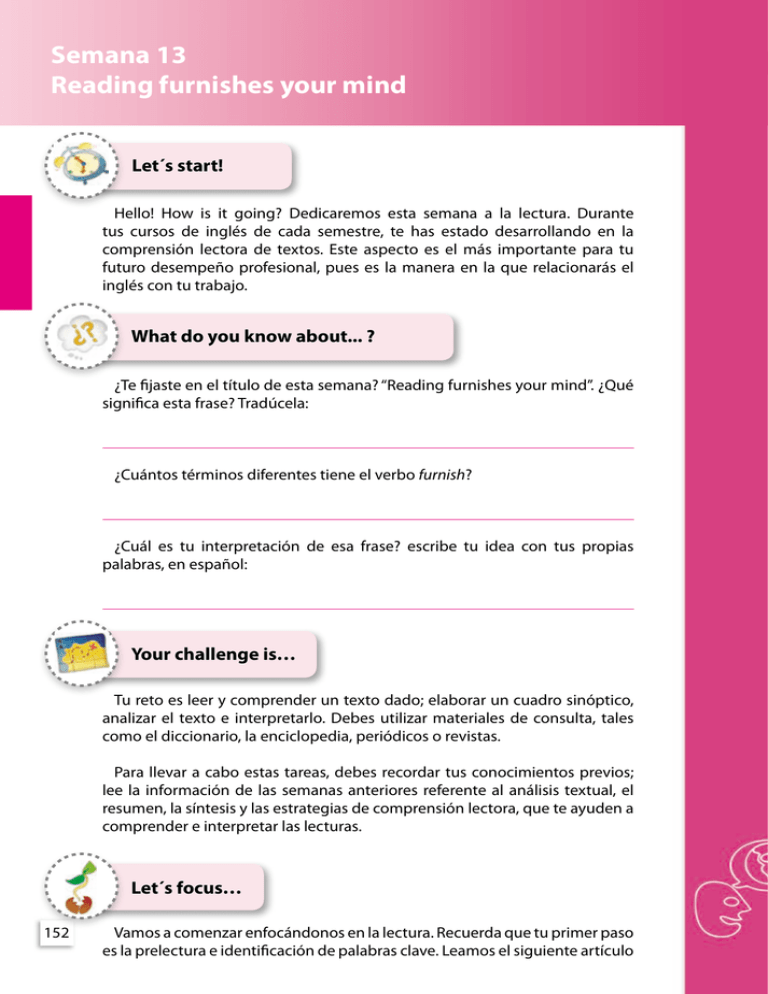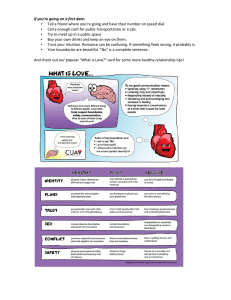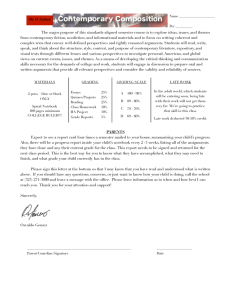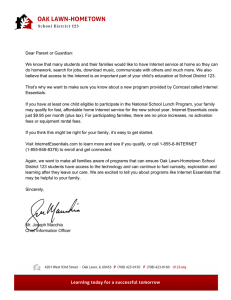Semana 13 Reading furnishes your mind
Anuncio

Semana13 13 Semana Reading furnishes your mind Reading furnishes your mind Let´s start! Hello! How is it going? Dedicaremos esta semana a la lectura. Durante tus cursos de inglés de cada semestre, te has estado desarrollando en la comprensión lectora de textos. Este aspecto es el más importante para tu futuro desempeño profesional, pues es la manera en la que relacionarás el inglés con tu trabajo. What do you know about... ? ¿Te fijaste en el título de esta semana? “Reading furnishes your mind”. ¿Qué significa esta frase? Tradúcela: ¿Cuántos términos diferentes tiene el verbo furnish? ¿Cuál es tu interpretación de esa frase? escribe tu idea con tus propias palabras, en español: Your challenge is… Tu reto es leer y comprender un texto dado; elaborar un cuadro sinóptico, analizar el texto e interpretarlo. Debes utilizar materiales de consulta, tales como el diccionario, la enciclopedia, periódicos o revistas. Para llevar a cabo estas tareas, debes recordar tus conocimientos previos; lee la información de las semanas anteriores referente al análisis textual, el resumen, la síntesis y las estrategias de comprensión lectora, que te ayuden a comprender e interpretar las lecturas. Let´s focus… 152 Vamos a comenzar enfocándonos en la lectura. Recuerda que tu primer paso es la prelectura e identificación de palabras clave. Leamos el siguiente artículo Semana 13 Reading furnishes your mind separado en varios párrafos; responde las preguntas debajo de cada párrafo, para identificar palabras clave. Science News Do you want to keep up with the latest research and discoveries in science? There are many good websites that you can visit to make that easy. One great site is called Science News for Kids. This site reports science news covering a wide range of subjects. The articles are written with the interests and educational experience of younger readers in mind, but adults will find this site suitable for them as well. 1. Look at the word “suitable”. The author believes that adults ______ a) won’t understand a site for kids. b) will find Science News for Kids useful. c) don’t like science as much as kids. Another wonderful site, one that I check out every day, is called Science Daily. The site is constantly updated with news, often about exciting findings that change how we look at the world and the universe. Whether it’s newly unearthed discoveries about creatures that have been extinct for millions of years, or the latest advances in cures for human diseases, you’ll find it at Science Daily. 2. What does “daily” mean? a) never at night b) only for scientists c) every day 3. What does “unearthed” mean in the paragraph? a) dug up b) from another planet c) shot into space These sites post stories as they become news and also archive all the past articles. That way you can enter a search term and find articles on just about anything related to science that they’ve ever published. Why not visit these fascinating sites and see what you think? You can find them at http://www.sciencenewsforkids.org/ and http://www.sciencedaily.com/. Fuente: rhlschool.com 153 Semana 13 Reading furnishes your mind 4. What does “archive” mean? a) a nest in a boat b) read carefully c) keep in a safe place Bien, ese fue el primer paso. Volvamos a los 3 párrafos que componen el texto, y sigue los pasos: • Lectura del primer párrafo para extraer la idea general. • Señalar las ideas más importantes: principales y secundarias. Ahora, responde: 5. What is the text saying? 6. What is the object that is under analysis? 7. Where do the ideas come from? 8. Why is this information valuable? Let´s know more… Es hora de aprender más, para seguir cultivando tus conocimientos. Busca la página web http://www.sciencenewsforkids.org/ haz click en la sección Tech and Math y extrae información acerca de “carros del futuro”. Escribe un corto texto en inglés (5 líneas) acerca de lo más resaltante. 154 Reading furnishes your mind Semana 13 Apply your knowledge 1. Vamos a leer y analizar un artículo. Observemos algunas imágenes primero… • ¿Cuál será el tópico de la lectura? • ¿Qué piensas de estos animales de las fotografías? • ¿Tocarías a alguno de ellos? Sí ¿A cuál? No ¿Cuál no, y por qué? En la lectura encontrarás el nombre de estos animales en negrita. Después de leer, regresa y escríbelos debajo de cada fotografía. Ahora, lee el título de la lectura. ¿Cuál es el tema o tópico? Can’t touch this: Unusual venomous creatures A continuación, lee el texto fragmentado que te presentamos en esta semana; puedes leerlo completo en tu DVD. Can’t touch this: Unusual venomous creatures Scientists study a cast of creatures to learn how to use toxins to treat pain and disease By Sharon Pochron / March 11, 2012 Even behind thick glass at the zoo, rattlesnakes look dangerous. After you’ve passed black mamba snakes, brown recluse spiders and bark scorpions, all of the zoo’s dark corners seem treacherous. The Komodo dragon, the world’s heaviest lizard, plays tug-of-war (pulling a rope) with its keeper. 155 Semana 13 Reading furnishes your mind In the bird exhibit, hooded pitohuis from Papua New Guinea flutter to the top perch in a colorful flurry of orange and black feathers. Their song fills the air. A duck-billed platypus, a strange Australian mammal, swims in quick circles in its murky pond while hunting for crustaceans. You’ve forgotten about the venomous snakes and spiders. However, even lizards, birds and mammals sometimes arm themselves with chemical weapons. You’ve just walked past three examples. They each possess powerful poisons. And these interest scientists not only because of how the chemicals aid in the animals’ defense but also because modified versions of these weapons may one day aid medicine. ¿Cuáles son estos tres animales venenosos que se mencionan en el primer párrafo? ¿Sabías que un pájaro podía ser venenoso? Big lizard, deadly bite Maybe you’re not surprised about Komodo dragons. You’ve probably heard that these lizards kill with a bacteria-ridden bite. Scientists, too, used to believe that story. The dragon’s teeth lack the grooves typically seen in venomous reptiles. But how dragons actually destroy prey is far more interesting. MRI images revealed a big surprise: six venom glands on each side of the dragon’s mouth. Dragons have a unique venom-delivery system. They puncture the flesh of prey with sharp, sawlike teeth. When prey pull away, dragons pull back. This action allows venom secreted from glands behind their teeth. A heart-stopping bird High levels of batrachotoxin, the same toxin used by poison dart frogs, are found in pitohui muscle, heart and liver. If eaten, the toxin interrupts the normal function of a predator’s nerve cells, eventually causing the heart to stop beating. 156 Mammals’ toxic spit and paralyzing poisons Mammals don’t use venom, right? Wrong. In 2011, Jonathan Kingdon, a biologist at the University of Oxford in England, discovered that the African crested rat can poison anything that touches it. So how does the rat become venomous? It chews up toxic tree bark and slathers its now-toxic saliva over specialized hairs. Reading furnishes your mind Semana 13 The African crested rat isn’t the only toxic mammal. Everyone agrees that platypuses are weird. This mammal lays eggs but nurses its young through specialized belly hairs. It hunts prey by using its duckbill to sense electrical currents (called electroreception). They use venom that they make themselves from scratch — just like venomous snakes do. Only male platypuses produce venom. Just above each webbed hind foot, males grow a bony spur that can deliver a poisonous strike. The venom doesn’t kill other platypuses. Tomado de: http://www.sciencenewsforkids.org/2012/03/cant-touch-this-unusual-venomouscreatures/ 2. Parea el vocabulario a continuación con su correspondiente definición. Adivina el significado a través del contexto. Puedes usar tu diccionario. a) Rattlesnakes 1. Magnetic Resonance Imaging. b) Glands 2. American snake with a series of horny rings on the tail. c) Mammals 3. Reptile with four legs. d) Lizards e) Venom 4. Vertebrate animal of a class (Mammalia) that is distinguished by the possession of milk-secreting organs. 5. An animal hunted and killed by another for food. f ) MRI 6. Poisonous fluid secreted by animals g) Prey 7. An organ of the body which secretes particular chemical substances. 3. Haz un cuadro sinóptico de la lectura. En la semana 12 hicimos uno; búscalo para que recuerdes cómo se llena. Copia el cuadro en una hoja blanca, llénalo y llévalo al CCA para compartir tus ideas con tus compañeros. Cada uno evaluará el cuadro de su compañero. Let´s show what we know… 1. Para demostrar tus conocimientos, debes hacer una síntesis de la lectura que aparece en Apply your knowledge. Ya tienes el cuadro sinóptico que te ayudará a elaborarla. Para redactar síntesis en inglés, debes usar ciertas estructuras puesto que vas a dar razones, a expresar 157 Semana 13 Reading furnishes your mind causa y efecto o darás tu opinión o sugerencias. Revisa el material del semestre 12 y busca las frases y palabras para dar razones. Lleva tu síntesis al CCA y léela a tus compañeros y facilitador. 2. Busca la última parte de la lectura de esta semana en tu DVD, titulada Toxins as painkillers. Léela y coméntala con tus compañeros del CCA. 158


